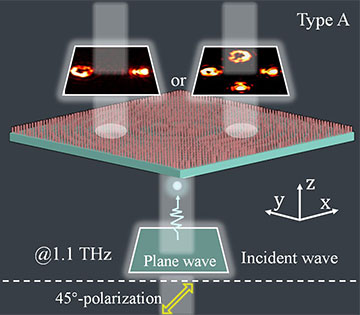
A superposition state of spherical and vortex waves created by an artificial metasurface can enable four-channel transmission of two spherical waves and two vortex waves. [Image: F, Li, University of Electronic Science and Technology of China]
Researchers in China have created all-silicon structures that can transmit terahertz waves over four distinct optical channels, allowing multiple functions to be performed at the same time (Photon. Res., doi: 10.1364/PRJ.477381). Such multichannel optical devices could offer a more versatile solution for terahertz imaging and quantum-information encoding, as well as for future 6G wireless networks that are likely to require high-frequency waves extending into the terahertz regime.
“In 6G networks, the multiple channels produced by our devices could be used to simultaneously achieve beam deflection at multiple frequencies,” said team leader Fuyu Li from the University of Electronic Science and Technology of China. “That would reduce the need for more base stations that would otherwise be needed to achieve full signal coverage.”
Spherical and vortex waves
The novel scheme exploits artificial metasurfaces to create a superposition between spherical and vortex terahertz waves. While spherical waves radiate outward in all directions, the twisting shape of vortex waves creates a rotational movement that can be used to carry information or move particles.
Compared with pure vortex waves, however, a superposition state of these two types of wave offers more opportunities to upgrade the capabilities of terahertz devices. “Such devices could increase the precision of particle manipulation, for example, or broaden the channels of optical communication,” adds Li.
The researchers designed two different metasurface structures that enable interference between spherical and vortex waves with specific linear polarizations, fabricating and testing a sample of each to verify both theoretical calculations and numerical simulations. One of the structures allows a superposition between vertically polarized spherical waves and horizontally polarized vortex waves, yielding an interference pattern consisting of three spiral fringes rotating in a clockwise direction. By separating the vortex wave from the spherical wave in the superposition state, the researchers showed that this type of structure enables two-channel transmission.
The other metasurface supports interference between spherical and vortex waves with the same polarization. In this case, the interference pattern consists of two rotating spiral stripes when both waves are horizontally polarized or four when they are vertically polarized. For this structure, both two- and four-channel transmission can be achieved when the spherical and vortex waves are separated.
Future directions
The researchers are now working to integrate more functionality into the metasurfaces and to improve the signal-to-noise ratio to allow observation of smaller physical phenomena produced by the structures.

